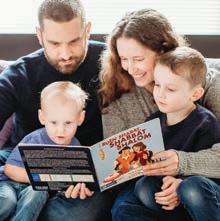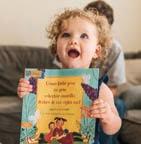Meet the visionary behind PJ Library p. 17
Bringing Jewish families together virtually p. 12
PJ Library in South Africa: a milestone p. 10

on page 14

Meet the visionary behind PJ Library p. 17
Bringing Jewish families together virtually p. 12
PJ Library in South Africa: a milestone p. 10

on page 14
July 2023 | Volume 9, Issue 17
Founder Harold Grinspoon
President Winnie Sandler Grinspoon
Chief Operating Officer Adrian Dion
Managing Director Alex Zablotsky
Chief Philanthropy Officer
Rachel Bren Goldklang
Director of Advancement Communications
Shelley Friel
Managing Editor Rachel Zaimont
Graphic Designer Allison Biggs
Contributing Editors
Senior Creative Manager Beth Honeyman
Creative Director Danny Paller
Contributing Writers
Andrea Arbel, Emily Benedek, Naama Krauz, Danny Paller, Joshua Sevitz, Lisa Trank, Rachel Wetter
Operations Support
Director of Data Management
Adrianne Levine
Operations Manager Renée Zborowski
Web Marketing Manager Rory Hurlburt
Stewardship Coordinator Jessica Kaleta
Database Coordinator Sherani Weatherington
Web Operations Associate Xavier Hillman
PROOF subscriptions: development@hgf.org
Donation inquiries: give@hgf.org
Questions about PJ Library: pjlibrary@hgf.org
Have a story idea? proof@hgf.org
Cover credit: Courtesy of URJ Camp Harlam
PJ Library 67 Hunt Street, Suite 100 Agawam, MA 01001 USA 413-276-0800 pjlibrary.org
Copyright © 2023 Harold Grinspoon Foundation. All
What do you say when you meet someone who has sent your child a gift every month for the past 10 years? At a loss for anything better when I first met Harold Grinspoon, I went with “Thank you.”
Already a PJ Library parent, I’ve now had the additional pleasure of working with Harold, the entrepreneur and philanthropist behind PJ Library. I’ve had the opportunity to witness his generosity, passion, and unrelenting commitment to the Jewish people.
There’s been a lot written about “big bet” philanthropy: transformational gifts, often to a university. But there’s not much written about Harold and his big bet on PJ Library. That’s why I’m so excited we’re featuring Harold in this issue of PROOF
From a humble and relatable start — he overcame a learning disability, he struggled to find his professional passion — Harold has gone on to build an incredible legacy defined not only by the gift of PJ Library but by how he’s inspired countless others’ philanthropy. He is known to ask others, “What do you want your legacy to be?”
Harold’s big bet gives us a legacy of Jewish continuity we can all uphold. When we read Jewish stories to our children; when we jump into the conversations they spark; when we decide to light Shabbat candles, enroll our kids in Jewish preschool, or pack them up for Jewish summer camp, we’re part of this legacy. And when we choose to support PJ Library financially, to ensure that other families will have PJ Library for their children, we’re cementing our own legacy as well.
In partnership, for our children,
Rachel Bren Goldklang Chief Philanthropy Officer PJ Library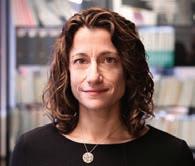
WILL YOU HELP TO GROW PJ LIBRARY FOR ALL OUR CHILDREN? Go to pjlibrary.org/donate to make a gift.

PJ Goes to Camp
Jewish overnight camp is a treasured experience for many children. Find out how PJ Library helps make camp more accessible for families.
The Surprise in the Envelope
What’s behind the puzzles, games, and other goodies that sometimes arrive with PJ Library books? Follow along to find out!
South Africa’s First PJ Library Graduates
PJ Library in South Africa celebrates a milestone: its first class of graduating kids.
Building Community
PJ Library’s All-Access Community helps Jewish families all over the US and Canada find connection.
Harold Grinspoon’s Gift
How did PJ Library begin? With the vision and generosity of its founder.
Sifriyat Pijama: Now for Young Toddlers
Israel’s innovative program for schoolchildren now reaches its youngest audience yet.
The Newsfeed
A quick take on what’s happening at PJ Library.
A young PJ Library subscriber is inspired to reach for his tzedakah box.
Parting Thoughts
A note from Winnie Sandler Grinspoon, president of the Harold Grinspoon Foundation.
“ I have two sons, ages 11 and 8, and we’ve been getting PJ Library books for as long as I can remember reading books with my oldest. I was raised in a Jewish household, went to a Solomon Schechter school through sixth grade, and always practiced Jewish traditions with my family. As I got older, my Judaism faded into the background. Then at 39, I met a nice Jewish boy, and we had kids and had to figure out how to be Jewish with them. One Hanukkah, after regaling our kids with too many presents, I realized that we were doing this gift giving totally out of context. I decided we needed to do at least one thing that would make our kids know they were Jewish. So we decided to do Shabbat every week. And we have been doing so, albeit a low-key quickie version, for years now.
But as it turns out, all along we were doing something else that was bringing Judaism into our home. We were getting PJ Library books every month. And this … this! … this has been what has made our kids Jewish. They know about all the holidays, funny Yiddish words, and the values that come from our culture, all because of these books. And they love them! They’ve never gone to Hebrew school, but they very strongly and proudly identify as Jews. And I swear, it has a lot to do with PJ Library. You have provided an education for our kids that they otherwise wouldn’t have had.
So I just wanted to say thanks for all of that. Your program has made a real difference in our lives. And continues to through PJ Our Way now too.
Thank you for everything!
SondraL., San Anselmo, California
*We want to hear from you! Send your thoughts, questions, and opinions on the articles in PROOF (and PJ Library in general!) to proof@hgf.org.
There’s always plenty going on at PJ Library. Here’s a quick roundup of the latest news and events.
BY PJ LIBRARY STAFFARE YOU LOOKING FOR A NEW HOME for those beloved PJ Library books your kids have outgrown?
There are many ways you can repurpose gently used books and give them new life. If books are in good condition, donate them to a local Jewish organization, such as a synagogue, preschool, day school, or Jewish community center. Family service organizations in your area may also have need of donated books. You can drop books off at a public library for its used-book sale or arrange a pop-up PJ Library corner in the children’s section (both great ways for other families raising Jewish children to discover PJ Library and for everyone to learn more about Jewish culture).

Kids can create collages or holiday table centerpieces from books too worn to donate.
PHOTO BY JAMIE LEFKOWITZWant to get active? Take a stroll around your neighborhood (or a friend’s) and have your children deposit their books in a Little Free Library bookcase. Want to make it a social event? Host a book swap in your community where kids can exchange titles or “shop” for new ones. If books are too worn-out to be donated,

consider an upcycling project. Kids can create a variety of crafts from old book pages with a few common art supplies, such as scissors, paint, glue, Popsicle sticks, and crayons. Think collages, origami, or paper flowers, to name a few.
“One of the most common things I hear from PJ Library families is the excitement of receiving and reading each month’s book. But the other thing I commonly hear is the question of what to do with books they have outgrown,” says Jamie Lefkowitz, a PJ Library parent connector in the Rivertowns area of New York.
Last year, Lefkowitz hosted a book swap followed by a crafting day to upcycle the leftover books. At Woodlands Community Temple in White Plains, New York, some 19 children created colorful paper flowers for holiday-table centerpieces.
“The book upcycling project gave new purpose to those books that did not find a new home,” Lefkowitz says. “They used these books to create something unique and meaningful that would be a reminder during their holiday gatherings of their creativity and Jewish identity.”
—By Rachel ZaimontIn February and March, PJ Library hosted the Great Passover Seder Giveaway. All PJ Library subscribers were entered to win and could earn additional chances to win by following PJ Library on Instagram and sharing the giveaway with others. And the prize? A Passover seder! Grand-prize winners would receive a package featuring a range of goodies to help families host an unforgettable seder.
Featuring a Jewish cookbook, aprons, kids’ matzah-print pajamas, and, of course, Passover-themed books and a set of the PJ Library Family Haggadah, the giveaway wowed our three lucky winners. “I want to offer my deepest gratitude for this amazing gift,” wrote Juan G. of Miami, Florida. “My family was so excited to see all the wonderful items for our Passover seder.”
—By Craig Rossein




PJ Library’s award-winning podcast network, PJ Library Presents, is reaching more listeners than ever — and gaining recognition. Afternoons with Mimi has recently become a Webby Awards honoree! This podcast for young children has a storytime premise, featuring PJ Library books, Jewish folktales, and original stories. Mimi and Beyond the Bookcase, a fantasyadventure series for older children following two friends in a magical land, had their most popular month yet this past March with more than 50,000 downloads. That’s over 50,000 times these Jewish stories were experienced, enjoyed, and shared in one month alone. The two shows have racked up more than 330,000 listens altogether. Production is now underway on season three of both shows.
Want to listen? PJ Library podcasts are now available free of charge on the Yoto Player; the Kids Listen app; and Apple, Spotify, and many other podcast platforms. You can also listen at pjlibrary.org/podcast. —By Alli Thresher
PJ Library is partnering with the JBI Library (formerly the Jewish Braille Institute) to offer PJ Library books in braille, large print, and audio formats for blind and visually impaired children and family members, enabling more families to read together.
The pilot program features four picture books: The Peddler and the Baker, Hanukkah at Monica’s, Until the Blueberries Grow, and Jeremy’s Dreidel. Each book has a braille transparency overlaying each page of text. In addition, JBI has produced PJ Library’s Passover Haggadah, In Every Generation: A PJ Library Family Haggadah, in braille, large print, and audio formats.
“We are excited that this partnership makes cross-generational reading together possible through different accessibility options,” says Livia Thompson, JBI’s president. “It will make possible the inclusion of visually impaired and print-disabled children in the PJ Library program and also provide a means for visually impaired parents and grandparents to read to their sighted children and grandchildren.”
“Our work with JBI is extremely important in helping us fulfill our mission to provide Jewish stories to all Jewish families,” adds Simon Klarfeld, PJ Library’s director of content. “No story is more central to the Jewish narrative than the story of the Exodus from Egypt and the freedom it enabled, so our collaboration on the Haggadah is especially meaningful.”
Interested in ordering a book in braille? Email aarfe@jbilibrary.org
—By PJ Library Staff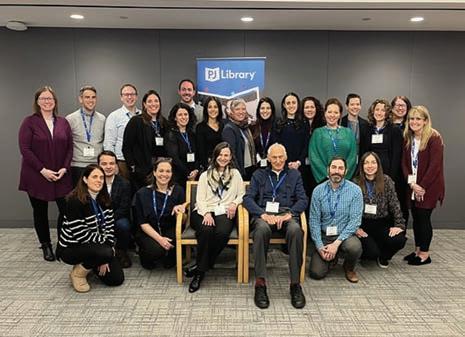
What does it take to deliver PJ Library books to children in more than 35 countries? Great stories in seven languages, a worldwide distribution network, committed donors, global partners, and incredible leaders around the world. In March, directors of PJ Library programs across the globe came together for the first time in three years in New York City. The PJ Library International Directors Conference facilitated three days of learning and collaboration focused on Jewish peoplehood and deepening PJ Library’s impact in their home countries. Hailing from São Paolo, London, Johannesburg, Hong Kong, and other locales, attendees brought energy and passion for PJ Library that transcends borders and time zones. “It was invigorating to come together with my colleagues from countries around the world, discussing book selection and family priorities in each of our regions,” says Lauren Hamburger, regional director of PJ Library Europe and Africa. “We’re already counting down until our next meeting.”
—By Rachel Kozupsky
Alongside the monthly book, PJ Library has sent puzzles, games, and other activities to families. What’s behind these special treats?
BY DANNY PALLER, CREATIVE DIRECTORApair of Shabbat candlesticks. A mezuzah on the doorpost. A kippah from Cousin Joey’s bar mitzvah. Whether these or other artifacts of Jewish life adorn your home, PJ Library has a few to add: a perpetual Jewish calendar on the refrigerator, a Mitzvah Pack on the coatrack, a Who Stole Hanukkah?! puzzle in the game bin.
These are just some of the many surprise gifts and activities that PJ Library has sent alongside the monthly storybook.
After its first full decade of sending free Jewish children’s books, PJ Library began responding to parents’ requests for “beyond-the-book” experiences as a means of deepening Jewish engagement in the home. PJ Library mailed one of its first activities in March 2016: a Passover Question Catcher. In the Passover
spirit of encouraging children to ask questions, families received foldable sheets modeled on paper fortune tellers — in this case, featuring fun questions for children to ask in preparation for the Passover seder (ritual meal). The team made this ready-to-use family activity as flat as a matzah so it could be tucked into the envelope with the book.
Since then, PJ Library has continued creating gifts for families to enjoy and sending them as a surprise in the same envelope as the monthly book. Each piece aspires to meet three criteria: 1. Be relevant. What are parents looking for to enrich the at-home Jewish experience? 2. Make the old new. How can PJ Library renew and refresh the way Jewish rituals or values have traditionally been presented? 3. Be quick and deep. How can a child-centered activity also involve and resonate with busy grownups?
One of the first in-envelope gifts: the Passover Question Catcher.
REARDONOver the past seven years, PJ Library has developed and mailed nearly 20 in-envelope presents to hundreds of thousands of children. Families used colorful decals to construct their own family tree, designed to spark stories and conversations about family history. Kids attached an eyecatching luggage tag to a backpack or suitcase, and — inspired by Tefilat HaDerech, an ancient Jewish traveler’s prayer — inserted their own wishes for summer travels. Families unfolded the Passover River Ride at the seder table to retell the dramatic story of the Exodus from Egypt. Kids wore a PJ Library apron to cook with family members in the kitchen — creating sweet Jewish memories — and slipped giftable items into their Mitzvah Pack to go out into the world to do acts of kindness. Guided by a childfriendly Perpetual Jewish Calendar, families learned about the cycle of the Jewish year, and, as a result, kept track of just when to enjoy a special peel-and-sniff Havdalah


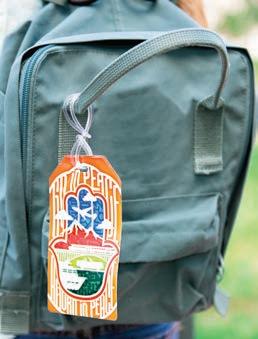



kit, distribute their Persian-style Purim gift basket, greet guests with their dangling Sukkot welcome mobile, or plant seeds on Tu B’Shevat (Jewish Earth Day) with their microgreens growing kit. And most recently, families celebrated Israel’s milestone 75th birthday by encountering diverse people and places in the groundbreaking Israel Trail Game
What has been the outcome of all these surprise activities? No surprise, really. Families post their delight on social media and send notes of appreciation. When we survey families, asking about the impact of these gifts, over 90 percent tell us they enjoy them. Children and
A selection of PJ Library in-envelope gifts, including the brand-new Israel Trail Game (bottom right).
BY
LYNDSAY HANNAH, STEPHANIE COHEN, AND BRIAN ACH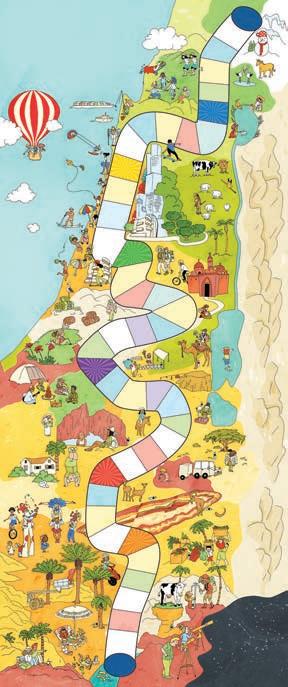
adults alike embrace these creative ways to connect with holiday traditions and customs.
“Passing this along for the game makers in the latest PJ Library book packets: We love them!” shares Shaina S. of Anchorage, Alaska. “The amount of thought and consideration that goes into these are amazing.”
What new special gifts are in the pipeline? We’re not telling. Would you really want us to ruin the surprise?
This past December, PJ Library mailed families with children ages 3 to 8 a surprise Hanukkah gift — a whodunit story called Who Stole Hanukkah?! with an accompanying jigsaw puzzle that kids could assemble to solve the mystery. That same month, PJ Library’s Instagram engagement spiked: Kids everywhere were cracking the case, piece by piece. We had a Hanukkah hit on our hands!
“The most recent book which we received, Who Stole Hanukkah?!, is an absolute gem.
Idea
“Joining a story with a puzzle like this — where the puzzle is integrally connected to the plot — was genius.”
Madelynn K.
My 5-year-old daughter absolutely loves it,” David S. from Fairfax Station, Virginia shares.
Adds Madelynn K. of Philadelphia, Pennsylvania: “Joining a story with a puzzle like this — where the puzzle is integrally connected to the plot — was genius.”
Now that families have succeeded in solving the mystery, let’s unpack yet another mystery: What goes into producing a gift like Who Stole Hanukkah?! Read on to learn how a simple idea became hands-on Hanukkah joy.
One day, Harold Grinspoon, the founder of PJ Library, said to the team, “Wouldn’t it be great to send kids a puzzle this Hanukkah?” We thought it over and replied, “Wouldn’t it be great to send a Hanukkah mystery book with a puzzle kids need to assemble in order to solve the mystery?” And we were on our way.
The Plan
We developed a plan to bring the product concept to life. First, we detailed the goals — in this case, building cognitive skills (let’s hear it for sleuthing!), reinforcing Hanukkah values and rituals, and supporting family togetherness and fun. Senior creative manager Beth Honeyman then created a production timetable (roughly a year) and held us to it, every step of the way.
I wrote a draft of the story, and Naomi Shulman, managing editor of PJ Publishing, improved it. (As they say, two is better than one.) We changed the ending a few times before we agreed on the “who” of the whodunit.
The Manufacturer
Renée Zborowski, our operations manager, is responsible for hiring the right manufacturer for each in-envelope piece. Following a rigorous review, she chose WPS Worldwide Printing Solutions, who helped create puzzle templates with the number of pieces and the shapes we wanted. We went with 30 pieces for ages 3 to 5 and 72 pieces for ages 6 to 8, and we decided to make the puzzles a little more challenging than a standard puzzle.
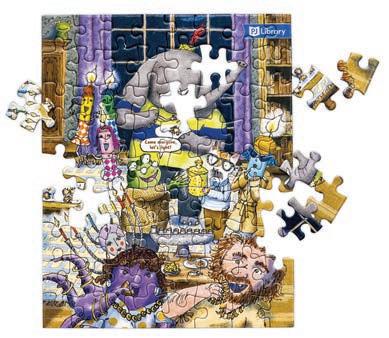
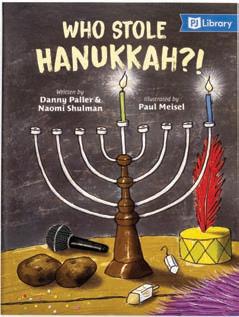
With the story complete, it was time to create the jigsaw puzzle, which, when assembled, would solve the mystery and reveal the Hanukkah thief! Barb took the final illustration in the story (hidden behind a sealed page) and merged it with the puzzle template.
When the story, illustrations, and puzzle art were finalized, we received sample books and puzzles. They looked great! We gave the go-ahead for mass production. Books and puzzles arrived at the PJ Library distribution center, where they were placed in envelopes and mailed around the world to arrive in time for PJ Library families’ Hanukkah celebrations!
Various team members weighed in, and as a result, Naomi and I inserted a clearer motive and planted more clues to add intrigue and make the detective look smarter. Barb Bastian, the senior graphic designer on the PJ Library team, shared tips on the visuals. As a result, the detective became more appealing, and the cat turned out … shorter!

Artist Paul Meisel illustrated one of my all-time favorite PJ Library books, The Schmutzy Family. I wanted some of that same Schmutzy fun in Who Stole Hanukkah?!, and luckily, Paul was in! I sent him the story, and soon afterward he began working.
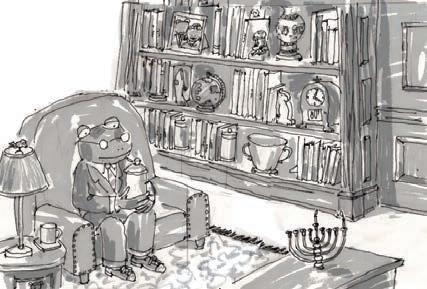
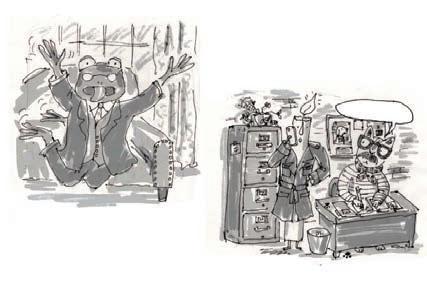
When Paul sent his first round of sketches, we made a mock-up, pairing the text of each page with Paul’s sketches. Everyone was getting excited — it started to feel like a book!

The first cohort of kids to enroll in PJ Library in South Africa recently celebrated their graduation. Their proud parents look back, and ahead.
BY JOSHUA SEVITZLeora Hessen has watched her daughter, Eden, gain much more than a library of Jewish-themed books from PJ Library over the years. The stories helped teach her independence, empathy, and the power of learning, to name a few.
“Receiving these books helped ignite a passion for reading in my child by exposing her to captivating stories,” Leora says. “The books have helped Eden explore different worlds, cultures, and perspectives, sparking her curiosity and imagination.”
Last November, Leora watched as Eden, age 8, joined her fellow second-grade classmates for a special graduation ceremony at their Jewish
In Jewish day schools across South Africa, second-graders held PJ Library graduation ceremonies.
PHOTO COURTESY OF UNITED HERZLIA SCHOOLS, CAPE TOWN, SOUTH AFRICA
day school. One by one, educators presented the kids with certificates. The children then sent letters of thanks to PJ Library in a bright red mailbox as they bid farewell to the program they had grown to love over the past five years.
Eden and her classmates were among some 1,200 Jewish children across South Africa who celebrated a unique milestone: They became the first cohort of kids in the country to graduate from PJ Library. Established in 2017 thanks to the generosity of the Gore family in memory of Daniella Moffson (see the sidebar for more), PJ Library in South Africa has become a beloved fixture in Jewish schools that parents of graduates say they will miss.
Across North America, PJ Library books arrive in the mail, but around the world, books are sometimes distributed in classrooms or at pickup locations. In South Africa, PJ Library serves about 2,200 children in 23 Jewish day schools, in partnership with King David Schools in Johannesburg and United Herzlia Schools in Cape Town.
Kids receive books in class once a month for eight months each school year, from age 3 to age 8. Preschool children wear their pajamas to school every month on book distribution day. “The younger children know that when they wear pj’s to school, they will be gifted a new book,” explains Andi Hendler, PJ Library’s Cape Town coordinator. “It’s a very exciting day!”
Teachers read books aloud in class and lead engaging activities for children tied to each story’s theme. After reading What’s the Buzz? Honey for a Sweet New Year, children got to meet a professional beekeeper. Kids baked cheesecake (while wearing their PJ Library aprons!) when they read Cheesecake for Shavuot. And students wrote get-well cards for young patients at a local children’s hospital after reading Bear Feels Sick. After each classroom activity, children take their books home to read with their families.
“As a school-based program, our teachers use PJ Library books to broaden Jewish values in the classroom and engage parents in the partnership between school and home,” Hendler says. “The most significant feedback we receive from parents and grandparents is their gratitude for supporting a love of reading and Jewish values in their homes. This demonstrates the value of PJ Library in building connections and promoting Jewish identity within the community.”
For Joanne Goldstein, whose son, Maxx, 9, is one of the graduates, PJ Library offered a chance for her family to learn together. “PJ Library puts the responsibility and the joy of Jewish teaching into the hands of parents — however much or little we may feel we know. The books give us the tools and the confidence to be our children’s teachers,” Joanne shares. “PJ Library really expanded our son’s Jewish literacy and knowledge — and did the same for whoever was lucky enough to read the books with him. He loved the feeling that he, the child, was teaching us, the parents, too.”
“Our
teachers use PJ Library books to broaden Jewish values in the classroom and engage parents in the partnership between school and home.”
ANDI HENDLER
Adds Leora: “These stories have enabled [Eden] to comprehend the essence of being Jewish and how to embody the qualities of a mensch.”
As Eden and Maxx graduate (with dozens of PJ Library books in their personal bookcases!), their mothers say they hope to continue what the program helped inspire: a family tradition of reading, discovery, and joy.
“PJ Library makes it so easy to connect with both the child and the beautiful values of our faith,” says Joanne. “Without it, we as parents just need to work that little bit harder to bring such moments into our busy daily lives with our kids. PJ Library was a wonderful jump start; it’s up to us to keep that engine running.”
Joshua Sevitz is head of Jewish life and education at King David Schools and the director of PJ Library in South Africa.
PJ Library in South Africa is made possible by the Gore family, whose generous support honors their niece of blessed memory, Daniella Moffson.
Daniella grew up in New York City, attending Jewish day school and Jewish summer camp, while maintaining strong ties with her family in South Africa. Deeply moved by Jewish values, she spent a gap year studying in Israel, where she volunteered with Magen David Adom and at a foster home for disadvantaged youth. She returned to study premed at Barnard College.
On January 13, 2016, Daniella was tragically killed in a bus accident in Honduras. After a week of volunteering with the Columbia University chapter of Global Brigades, the bus in which Daniella was traveling crashed on its way to the airport. She died as she lived — giving to others.
Daniella’s family helped establish PJ Library in South Africa as part of their commitment to carrying on her legacy. According to Daniella’s aunt Lauren, the program epitomizes what Daniella cared about most: giving to others, promoting Jewish values, honoring tradition and history, and being welcoming to all.
How PJ Library’s All-Access Community connects families in far-flung parts of the US and Canada to Jewish life — and to each other.
BY NAAMA KRAUZ , ENGAGEMENT ASSOCIATE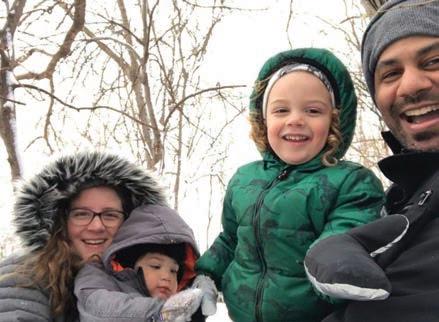
In Waterloo, Iowa, Erin Maidan Paige’s family is thankful for the community they have found through the PJ Library Families Facebook group. Erin loves that she can ask questions, discuss Jewish topics, and brainstorm with people all over the US and Canada. It has been a safe and fulfilling space to have Jewish conversations that are hard to come by in her Iowa neighborhood — and it has even allowed her to bond with others over a shared love of Jewish comics. “It’s such a supportive Jewish community, regardless of topic,” Erin says. “As an isolated Jew, that means the world to me.”
The tenor of conversations in the PJ Library Families Facebook group is respectful and encouraging. Although the All-Access Community is large — comprising more than 13,000 families in the US and over 1,100 in Canada — many families have forged deep connections online.
PJ Library’s All-Access Community is similar to many other PJ Library communities around the country but with one major difference. As in other communities, families share the experience of receiving PJ Library books every month, and parents lean on one another for questions, tips, and resources. But unlike other groups, the All-Access Community is comprised of a constellation of families raising

Iola Kostrzewski lives in Rochester, Minnesota, in a rural area that is home to few other Jewish families. Iola’s family was able to build their sukkah this past year with assistance from those in the Facebook group who shared suggestions for materials to use. Group members even offered problem-solving ideas when building a sukkah with a newborn baby in tow seemed too daunting. As Iola shares, “There’s a grace that’s given in the group, that if you don’t quite get it right, it’s OK — we’ll figure it out [together].”
Many All-Access Community families are not able to easily find Jewish ritual items that are readily available in stores in large cities. In the Facebook group, parents are quick to provide links to items they’ve found online and happily share accommodations they’ve made that satisfy the needs of observing a holiday or ritual.
Jewish children all across the US and Canada who don’t live in places with large Jewish populations or who live in towns just beyond our local partner’s service area. Those eagerly anticipated PJ Library envelopes find mailboxes on every corner of the continent — and sometimes in remote locales. Regardless of where All-Access Community families live, one way that they find support, connection, and programming is via the PJ Library Families Facebook group. Open to anyone but uniquely special to families without a Jewish community
The All-Access Community has become a shining example of how the virtual world can promote learning, laughter, and love.
nearby, the group allows parents to ask for advice, share experiences, post pictures of their kids, and inspire one another with Jewish cooking and crafts. Facebook has turned the All-Access Community into one that is closeknit, and it has become a shining example of how the virtual world can promote learning, laughter, and love.
Join the conversation in our PJ Library Families Facebook group: facebook.com/pjlfamilies.

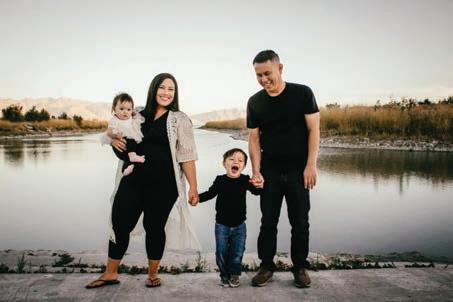
Shaina Seidner and her two children in Anchorage, Alaska, love the communal Jewish experience brought to them via PJ Library’s Virtual Tot Shabbat with the New York-based Leffell School. “My older daughter, age 3, really enjoys hearing the music, singing the songs, and seeing the other kids singing and dancing too,” Shaina shares. Though Anchorage has a small Jewish population, the Seidner family relies on the virtual programs offered by PJ Library’s All-Access Community to bring a sense of kehillah (community) into their home.
The Facebook group offers live and recorded virtual events for families, ranging from musical Tot Shabbat programs to holiday cooking experiences. Registration is easy!
In Saratoga Springs, Utah, Sylvia Lam loves how her children are able to explore Jewish holidays through art via the All-Access Community holidaycard exchanges for Rosh Hashanah and Hanukkah. The homemade-card exchange has allowed Sylvia to get to know other families and has even helped her connect with a few in her area. Every year, families eagerly share the cards they receive in the Facebook group, marveling at one another’s artistic talent and creativity.
Families can register for card exchanges through the Facebook group. PJ Library professionals try to match families with children of similar ages or interests to help make more meaningful connections among families.


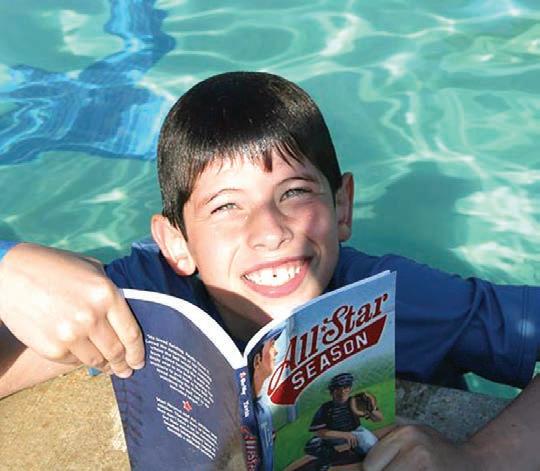







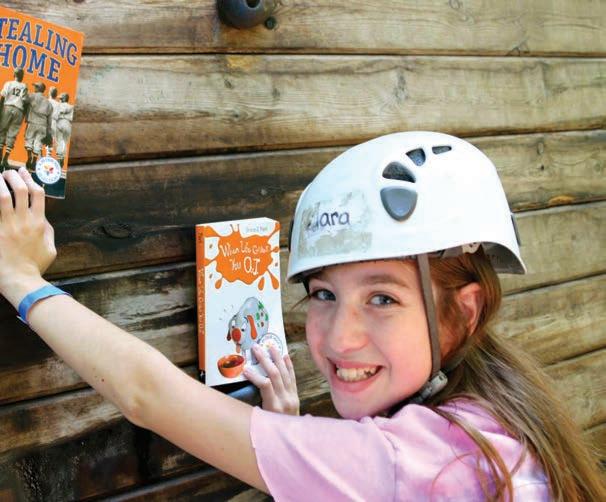
Sending a child to overnight camp for the first time can be hard. PJ Library helps make the choice easier.
BY LISA TRANKLauren Gell remembers the moment she learned the transformative power of Jewish camp. Her then-7-year-old daughter, Frankie, had just finished her first summer camp session at Tamarack Camps in Michigan, and she could hardly contain her enthusiasm.
“She bounded off the bus and told us that she had the time of her life and she was going for the whole summer next year,” Lauren recalls. Lauren and her husband, Jared, had been a little nervous about sending their younger child to camp since she had never slept away from home before. “We didn’t know which way camp would go,” Lauren shares. “But Frankie felt like she was a part of something and felt loved. She came back a different person.”
Outdoor activities, close friendships, Jewish communal celebrations — Jewish overnight camps offer a range of opportunities and experiences.
PHOTOS COURTESY OF KELLY RUBANENKO AND B'NAI B'RITH CAMP OREGONJewish summer camp is a treasured experience for many children — one that fosters Jewish learning, a strengthened sense of identity and cultural pride, and, often, a lifetime of joyful memories and friendships. But like Lauren, many parents hesitate that first year, questioning whether camp will be right for their child. That’s where PJ Goes to Camp — an initiative that offers an incentive to help families choose Jewish overnight camp — comes in.
Every October, PJ Library books arrive with a special sticker affixed to the envelope, encouraging families to sign up for PJ Goes to Camp. In partnership with the Foundation for Jewish Camp’s One Happy Camper program, PJ Goes to Camp provides up to $1,000 to defray the cost of overnight camp for first-time campers.
This summer, more than 1,170 children throughout the US and Canada are experiencing Jewish overnight camp for the first time with the support of a PJ Goes to Camp grant. Over the past 13 years, PJ Goes to Camp has awarded more than 8,000 grants totaling $8.1 million to broaden access to the joy of Jewish camp.
The benefits are quantifiable. According to the Foundation for Jewish Camp’s 2022 Census Report, some 92 percent of camp families said overnight camp made their child feel part of the larger Jewish community and peoplehood. As adults, campers are 21 percent more likely to feel that being Jewish is very important, according to Camp Works, a seminal Jewish camping industry report that established the importance of camp and its long-term positive impacts.
“The mission of PJ Goes to Camp is to introduce the wonder of Jewish camp to new campers who might be considering camp. It makes Jewish camp more attainable and accessible for families and starts them on a lifetime of camping memories,” says Sarah Eisinger, director of JCamp 180, a program of the Harold Grinspoon Foundation. “We know that first-time campers who receive One Happy Camper incentives, including PJ Goes to Camp, overwhelmingly return to camp for a second and third year, so this targeted investment in first-time campers is both great for families and for our Jewish ecosystem.”
In the 1980s, compelled by his desire to help kids build lifelong Jewish connections, philanthropist Harold Grinspoon wanted to make the Jewish camp experience more accessible and started a program offering tuition assistance for Jewish summer camps in Western Massachusetts.
By the mid-2000s, word had spread. Jerry Silverman, the then-director of the Foundation for Jewish Camp, reached out to expand Harold’s efforts nationally, eventually creating the program that would become One Happy Camper.
Where does PJ Goes to Camp come in? Despite the array of opportunities for
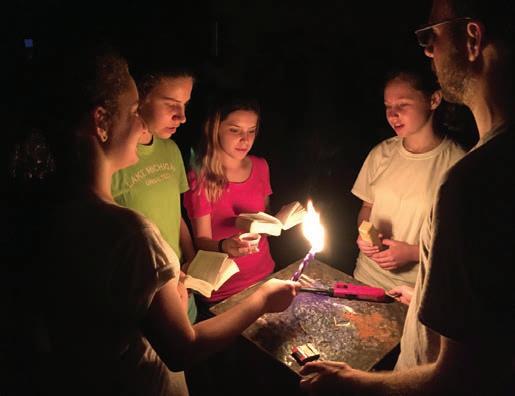
Above: Kids at a Jewish overnight camp take part in Havdalah after Shabbat. Below: Campers often form lasting friendships.
support through One Happy Camper and individual camps, not all families may have a local opportunity or fit the criteria. PJ Goes to Camp is there for them, ensuring that families enrolled in PJ Library have an incentive to help them choose Jewish summer camp for the first time.
As PJ Goes to Camp’s popularity grew, demand outpaced the number of grants, and a waitlist formed. To meet the demand, Harold reached out to philanthropic partners with a simple question — would they lend their support to grow PJ Goes to Camp, to get more kids into Jewish camps? Funders such as the Goldrich Family Foundation and the Klaff Family Foundation replied with a resounding “yes.” Together, these funding partners made a commitment to help bolster the Jewish future.
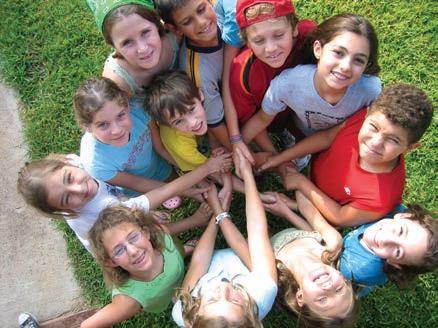
When the pandemic hit in 2020, Jewish overnight camps, like much of the world, shut down. Families wouldn’t be attending, and camps were poised to incur a financial loss. It was an existential crisis. Foundations, federations, individual donors, camp families, and others committed to Jewish summer camp marshaled their resources to help the camps weather this unprecedented time. Sparked by a matching grant from the Harold Grinspoon Foundation, some 32,000 donors lent their support
Over the past 13 years, PJ Goes to Camp has awarded more than 8,000 grants totaling $8.1 million to broaden access to the joy of Jewish camp.
over the course of three years to ensure summer camps would long outlast the strain of the pandemic.
The good news? Jewish camps have not only survived but rebounded stronger than ever. To ensure that strength into the future, the Harold Grinspoon Foundation last fall announced a new $25 million matching grant that will provide support for more than 100 nonprofit Jewish overnight camps over the next five years. The Forward Together grant initiative will help fund the staffing and infrastructure camps will need for generations to come.
For PJ Library families whose children are growing up — and who are on the cusp of making their next Jewish decision — One Happy Camper and PJ Goes to Camp offer a doorway into a vibrant Jewish experience.
And for the Gell family, whose 11-year-old son, Teddy, also attends Tamarack Camps, Jewish summer camp continues to play an important role. “[It] reinforces Jewish values and strengthens our family’s sense of our Jewishness,” says Lauren. “Frankie is so happy there. She feels safe. She feels at home.”
Lisa Trank is a Colorado-based writer and an alum of the Wilshire Boulevard Temple Hess Kramer/Gindling Hilltop Camps located in Malibu, California. She attributes her strong and positive Jewish identity and many lifelong friendships to this formative experience.

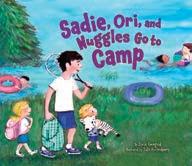

Sadie, Ori, and Nuggles Go to Camp
Age: 4 years
For the first time ever, Ori is going to sleepaway camp — and he’s feeling nervous. Can he bring Nuggles? Or will the other campers laugh at him? Sadie helps him out.
Sam and Charlie (and Sam Too) at Camp!
Age: 6 years
Best friends Sam and Charlie are heading to sleepaway camp for the first time. Luckily, they’re going to the same camp! They’re in for many adventures — and a few lessons.
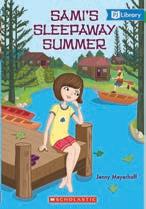

WANT TO LEARN MORE? Visit pjlibrary.org/camp.
Want to support Jewish camps? Find out if the camp you love is part of the Forward Together grant and join us in helping camps thrive!

Sami’s Sleepaway Summer
Age: 7 years
Though her family doesn’t seem to see it, Sami is absolutely certain she’s not a “sleepaway camp kind of kid.” Will a four-day, three-night minisession at Camp Cedar Lake change her mind?
Shabbat Sabotage
Ages: 9 to 12 years
It’s Maya’s first time at summer camp, and she’s got a secret she’d rather her bunkmates didn’t find out about. But she’s not the only one hiding something ...
The Sun Will Come Out
Ages: 9 to 12 years
Eleven-year-olds Bea and Frankie have been planning their first summer at Camp Shalom forever. But then Frankie gets into horse camp! How will Bea replace her best friend for a whole summer?

Families around the world love PJ Library. Meet the visionary who started it all.
BY EMILY BENEDEK“In those days, as a kid, you couldn’t be a lefty. So my mother made me a righty,” recalls Harold Grinspoon, the 94-year-old founder of PJ Library, who was born left-handed. When it came time for Harold to go to school in Auburndale, a village of Newton, Massachusetts, in the 1930s, the attitude was clear: His lefthandedness had to be changed.
But it didn’t go well. Harold had trouble reading, writing, spelling, and speaking clearly.
“My poor mom. I can’t spell today, and I never could spell. So she took me to spelling lessons, speech lessons, posture lessons,” Harold remembers. (Decades later, psychologists began to realize that changing a child’s dominant hand may lead to learning difficulties, stuttering, and dyslexia.)
And that wasn’t Harold’s only trouble — the kids in his neighborhood didn’t think kindly of him because he was Jewish. Even though his family wasn’t particularly religious, schoolyard bullies called him “Christ killer” and “Jew boy.”
Harold Grinspoon founded PJ Library to inspire children to love being Jewish. PHOTO COURTESY OF THE HAROLD GRINSPOON FOUNDATION
Despite so many setbacks to overcome, Harold persevered. He used those early hurdles as fuel to build a big life and touch as many people as he could through his twin philanthropic causes: Judaism and literacy.
PJ Library today sends more than 650,000 Jewish-themed children’s books to families in more than 35 countries each month in seven languages — at no cost to recipients. Since 2005, PJ Library and its Israeli sister program, Sifriyat Pijama, have distributed some 50 million books, making Harold, a Jew who doesn’t regularly attend synagogue and someone who can’t read easily, the person who created the world’s largest Jewish book program. None of this could have been accomplished without the generosity of Jewish philanthropists across the country and the globe, whom Harold says he is privileged to call his partners.
“I chuckle about it all the time,” he says. “I was the kid who struggled with reading and spelling, but I have always loved stories. When I thought about the power of stories and conversation to pass on the richness of Jewish life and I discovered that there were beautiful Jewish children’s books on the market, I saw an idea worth moving forward. If you are entrepreneurial, you find ways to reach your goals.”
THE FOURTH OF FIVE children, Harold distinguished himself early through his entrepreneurial spirit. As a boy he sold vegetables and eggs for his father and uncle. Harold’s father, Simon, who passed the Massachusetts bar exam before graduating law school, gave up practicing law to work with his hands. He loved farming the two acres in his backyard and went into the business of making small boats. The family struggled to make ends meet.
One summer, when Harold was in his early 20s, he operated a fleet of 30 Howard Johnson’s ice-cream trucks and was shocked to realize he made more money in one summer than his father had ever made in a year. Then in the late 1950s, when he was 30, he bought a run-down two-family house in Agawam, Massachusetts, fixed it up, and sold it. He used the proceeds to purchase a four-family home, then a six-family home, and then a 10-unit building.
Harold eventually created Aspen Square, a property management company that is now one of the top 50 privately held property investment and management firms in the US. The company still buys and rebuilds apartment complexes, turning them into attractive, well-maintained properties.
AFTER A BOUT WITH TONGUE CANCER when he was 59, Harold began to think about his legacy. His wife, Diane Troderman, his friend Rabbi Yitz Greenberg, and his business partner Jeremy Pava encouraged him to lay the groundwork to establish his philanthropic foundation and its goals.
Harold knew he wanted to give back to the Jewish community. Despite his lack of formal religious instruction, he had an enduring pride in his people.
“Jews have made amazing contributions to this world,” he says.
What might his own contribution look like?
The program expresses Harold’s abiding hope: “That we can hold different perspectives and viewpoints, and we can engage with our Judaism differently, but yet remember that we are one people.”
As he contemplated this question in the mid-2000s, Harold heard a radio program about Dolly Parton that caught his attention. Inspired by her father’s illiteracy, in 1995 she had founded Dolly Parton’s Imagination Library, a nonprofit that distributes free books to children to encourage them to read and to give them a wider glimpse of the world.
“My dad didn’t get a chance to go to school,” Harold heard Parton say on the program. Her father’s inability to read or write was “crippling” to him, she noted. Harold could in part identify with this sense of shame. He contacted Parton and became a local funding partner of Imagination Library. But he wanted to do more. And he wanted to connect his urge to help with his Jewish roots.
Harold once operated a fleet of ice-cream trucks before his property management career.
Winnie Sandler Grinspoon helped inspire him to create PJ Library.
PHOTO BY MICHELE CARDAMONE PHOTOGRAPHYAround the same time, Harold attended a Passover seder with his family. As prizes for finding the afikomen, his daughter-in-law Winnie Sandler Grinspoon gave her children Jewish-themed books. Harold was struck by how excited the kids were to get their books — very different from the way he would have reacted as a child.
Harold asked Winnie all kinds of questions: “Do the kids like getting books? Do they have other Jewish books? Where do you get them?” A week or so later, Harold asked Winnie to buy him $500 worth of similar titles. “I brought them over to their house,” Winnie recalls, “and he and Diane read them all.”
In 2005, Harold created PJ Library, and Winnie, now president of the Harold Grinspoon Foundation, is moving its mission forward. From its local beginnings in Massachusetts,
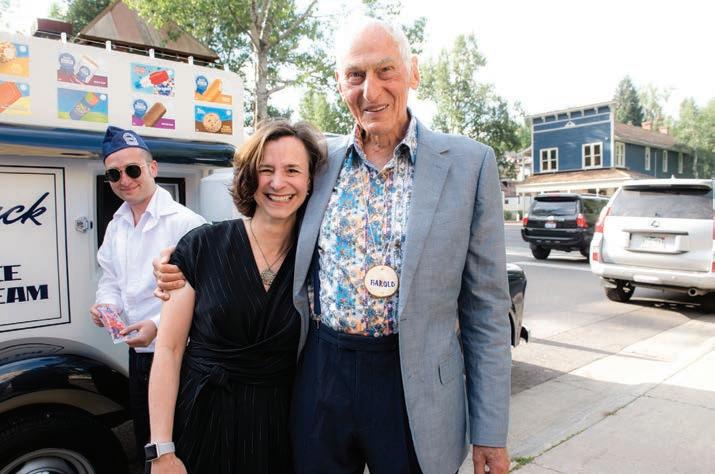
the program has grown to serve families across the US and Israel and around the world — including Venezuela, Ukraine, and Australia, to name a few. Tens of thousands have been inspired to join Harold with philanthropic support to help PJ Library flourish and reach even more children. Many of the children who receive books have only one parent who grew up Jewish. Many live in towns where there are no other Jews. Still others have thriving communities nearby. A significant number report that PJ Library is one of few resources to educate their children about Jewish values.
According to Eric Robbins, CEO of the Jewish Federation of Greater Atlanta, “PJ Library is one of the most innovative and thoughtful ideas that the Jewish world has seen. Think of it: A gift from the Jewish community is arriving every month in my mailbox — with my child’s name on it — a book that is adding to a growing Jewish library in our home. And no one is asking me for money for it. It’s revolutionary. Also, it’s nonjudgmental. You say you’re Jewish? Fine, that’s good enough for us.”
Like the act of reading Torah, in which Jewish people around the world are bound together through a shared weekly text, PJ Library similarly distributes common Jewish stories each month to Jewish children in countries across the globe. In this way, the program expresses Harold’s abiding hope: “That we can hold different perspectives and viewpoints, and we can engage with our Judaism differently, but yet remember that we are one people.”
FOUNDING PJ LIBRARY is just one of many philanthropic investments Harold has made on behalf of the Jewish people. He has also created JCamp 180, which supports the Jewish camp experience; Life & Legacy, which supports the future of Jewish communities across North America; Voices & Visions, which employs the power of art to inspire creativity and conversation, and more. Together, these programs share the goal of strengthening Jewish families and supporting Jewish institutions.
In addition to his professional endeavors, throughout his life Harold has loved skiing, hiking all over the world, biking, and all forms of travel. About eight years ago, he took up sculpting and has produced more than 150 large-scale pieces.
Harold’s lifetime of Jewish contributions underscores a common theme — to Harold, it’s all about applying creative ideas to build a better world.
“He’s an inveterate fixer,” says his son Steven Grinspoon. “And now, he wants to celebrate. And he wants us all to celebrate with him — his zest for life and positivity.”
A version of this story was published in Tablet magazine on August 19, 2020, and has been updated with new reporting.

In 2014, when Jake Kotin was 3 years old, he received the five millionth PJ Library book — which Harold Grinspoon and Winnie Sandler Grinspoon delivered to his Natick, Massachusetts home in person! Recently, Jake, now 13, got to chat with Harold and catch up.
HG: Do you remember the day I came to visit you?
JK: I heard a knock at the door. I went to answer it and you were there and Winnie was there. You read a book to me — it was about a Purim bear. I was ecstatic because I was like, “New people and a new book!”
HG: Do you remember the early books you received?
JK: I remember the gist of almost all of them. It always had some tie to Judaism, whether it be a Jewish holiday, Jewish morals, or a Jewish character. It connected me back to who I am. Every time a new book would arrive, I would run to the door and I would be super excited.
Now that I’m older, one of my favorite things about PJ Our Way is the aspect of choice. I appreciate how you can select books that align with your interests.
HG: That’s amazing. You’re amazing!
JK: I just had my bar mitzvah, and it was the coolest experience. I’m so glad I put in the work to make it uniquely my own.
I look back and so many kids are benefiting from your generosity, your kindness. And I’m just so thankful that I got to be part of this and a recipient of all these books.
Know a PJ Library alum who would like to share their story with PROOF? Let us know: proof@hgf.org.
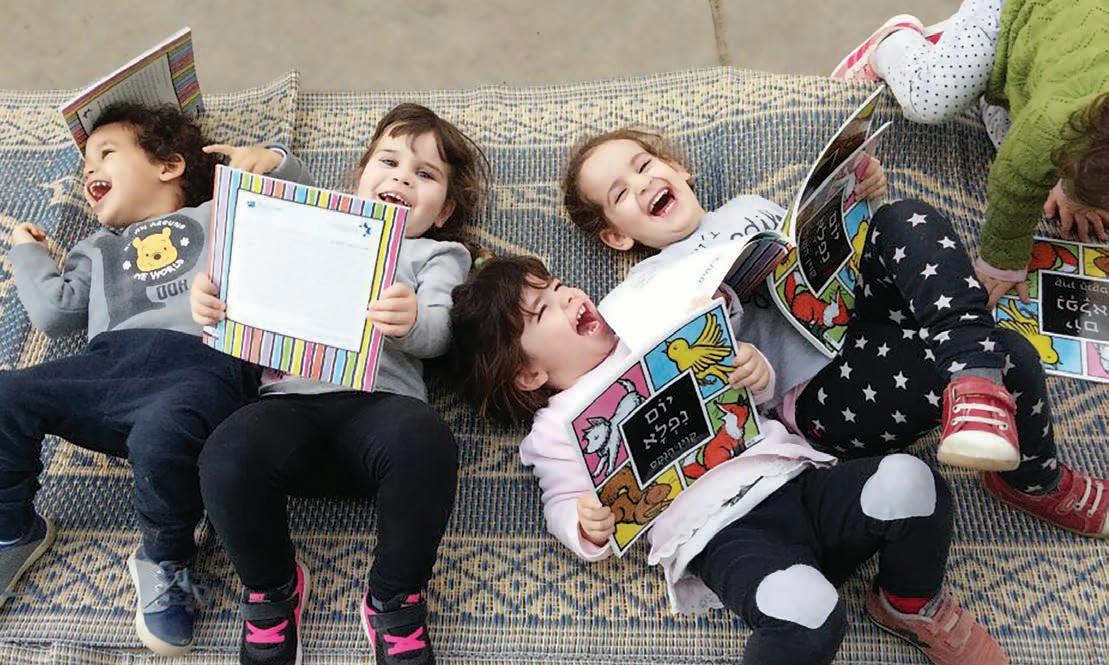
Israel’s innovative program for schoolchildren now reaches its youngest audience yet.
BY ANDREA ARBEL, EXECUTIVE DIRECTOR OF KEREN GRINSPOON ISRAELEver since Noa Pe’er’s daughter, Gaia Avraham, received the book, Why Does the Zebra Wear Pajamas? at her day care center in Israel, it’s been the 2-year-old’s favorite.
“She asks me to read the story to her every night before she goes to bed,” says Noa, who lives in Kiryat Malachi, a town in Israel’s southern district. “At a certain point, she started to tell me the story. We play a sort of game where she ‘reads’ a sentence and I read a sentence. I am filled with pride that my daughter, who is not yet 3 years old, loves a book and can learn so much from it.”
Noa’s story is not uncommon among parents in Israel, where PJ Library’s sister program, Sifriyat Pijama (“Pajama Library”), delivers more than 2.5 million books about Jewish and Israeli culture to children each year.
Sifriyat Pijama recently expanded book distribution to children ages 15 months to 2 years.
PHOTO COURTESY OF KGI PR
Founded in 2009 through a partnership between Keren Grinspoon Israel (the Harold Grinspoon Foundation’s presence in Israel, also known as KGI) and the Israeli Ministry of Education, Sifriyat Pijama gives the gift of highquality books to about 330,000 children ages 3 to 8. Sifriyat Pijama for Little Kids (SPLK), an extension program established in 2015, offers vibrant picture books to some 21,000 children ages 2 to 3 (including Noa’s daughter) in nearly 900 day care centers across Israel.
Like PJ Library, Sifriyat Pijama and SPLK offer children enriching books that spark joy and wonder. Unlike PJ Library, these books are distributed in the classroom and come with resources and activities to help teachers bring the stories to life. Each child receives their own copy of the book, allowing parents to share in the fun and learning at home.
The goals of Sifriyat Pijama and SPLK are
Sifriyat Pijama Distribution:
to inspire meaningful connection with children’s literature, enrich children’s language skills and vocabulary, nourish their imaginations, and help them develop a love of reading.
“Book-distribution day in kindergarten is really a holiday,” shares Laly Avraham, who has four daughters who have received books at school in Jerusalem. “The stories are a source for the children to do so many creative things in the classroom. We also have wonderful one-on-one time [at home] that enables us parents to be involved in the content. This is a blessed program that creates dialogue and quality time with the parents.”
Once the Sifriyat Pijama extension, SPLK, was solidly established in day care center networks such as WIZO, Naamat, Emunah, and the Community Center Association’s Smart Beginnings centers, day care center leaders began to ask: Can SPLK expand to include even younger children? These early-childhood experts understood the importance of creating a culture of reading early, starting with the youngest toddlers.
It was an irresistible idea, and KGI got to work. This past academic year, under KGI’s leadership and with support from the Wiener Philanthropy and the Max and Marian Farash Charitable Foundation, SPLK launched a pilot program to include young toddlers ages 15 months to 2 years.
How does it work? Based on Sifriyat Pijama’s successful model of programming, SPLK books for young toddlers arrive in day care center classrooms, where educators read the stories aloud and lead interactive book-related activities, including conversation starters and age-appropriate games, before sending a personal copy of the book home with each child. In addition, SPLK provides two more copies of every book to help day care centers across Israel build their on-site libraries. SPLK also conducts professional training sessions for day care center leadership and
staff to help them get the most out of the program. The pilot phase has been so well received so far that SPLK organizers hope to double the program’s reach over the next three years with donor support.
“Keren Grinspoon Israel’s recognition of the importance of reading at the youngest of ages is inspiring. There is clear and strong evidence that reading books to babies and toddlers contributes to their linguistic development and social-emotional learning and promotes the habit of reading and love of books in the family,” says Dorit Aram, Ph.D, a professor at Tel Aviv University who studies early childhood literacy. “It is critical that young children experiment with books, hold them in their hands, and listen to the story over and over again while participating in the reading. The SPLK program makes a vast and unique contribution to the world of literacy among Israel’s youngest children and their families.”
As Israel celebrates its 75th birthday this year, KGI’s leadership says the organization is proud to advance literacy among Israel’s newest generation in this innovative way. And families are grateful. Says Noa, “For me, this is an experience of true quality time and learning that is worth everything.”
Committed donors came together to enable Sifriyat Pijama for Little Kids (SPLK) to reach more children sooner. Funding comes in part from the Harold Grinspoon Foundation, the Wiener Philanthropy, and the Max and Marian Farash Charitable Foundation — with parents and other sponsoring organizations generously contributing to help this program grow.
“The Max and Marian Farash Charitable Foundation is thrilled to support Sifriyat Pijama for Little Kids,” says CEO Jennie Schaff, Ph.D. “The importance and promise of early literacy support cannot be underestimated when thinking, dreaming, and planning for positive outcomes for youth into adulthood.”
Eli
Bloodworth found out he could help other children access the joy of PJ Library. He reached for his tzedakah box.
BY RACHEL WETTER ADVANCEMENT COORDINATOR“Iwant to help other Jewish kids so they can read Jewish books too.”
So says Eli Bloodworth, who was 8 years old when he decided to donate to PJ Library. His family in Milledgeville, Georgia received a letter in the mail that described how important gifts of all sizes are to deliver PJ Library books to children around the world. Eli acted quickly: “He didn’t even say anything about it. He just took the envelope off the counter, and it reappeared, filled with a bunch of money from his PJ Library tzedakah box,” says his mother, Allison Bloodworth.
“He said he wanted to make sure that everybody would keep getting PJ Library books,” she recalls, “because he has seen the value in his life and in his younger brother’s life.”
The Bloodworth family started receiving PJ Library books in 2018, when Eli was 5. Living in the small town of Milledgeville, 30 miles from Macon, Georgia, the family doesn’t have much access to a Jewish community. They only learned about PJ Library when Eli’s father, Brian, spotted a PJ Library bookmark at a diner on a trip to Atlanta with Eli. “Brian was like, ‘You’re not going to believe what I found!’” recalls Allison. The program was perfect for Eli, who was already an avid reader.
Eli and the whole family (including little brother Cohen, who has just started receiving books) soon found that the value of PJ Library transcended engaging stories. For Brian, who is not Jewish, it was a new way to learn about Jewish customs alongside his sons. And for Eli, it was an incredible boost to his Jewish identity.
Seeing himself reflected in books is a big deal for Eli, who is now 9. He travels weekly to a synagogue in Macon for Hebrew school but finds that with many of his friends in Milledgeville, “I have to explain things every holiday,” he says. “I feel lonely because I like
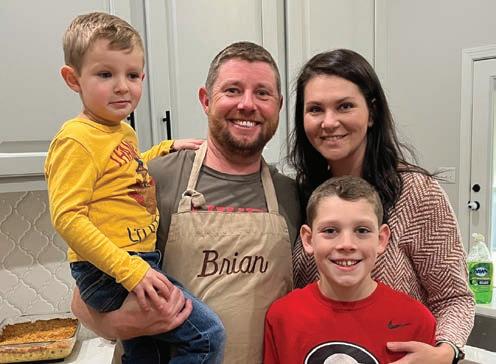

celebrating with other Jewish kids.” PJ Library books, however, gave him helpful language to explain the holidays and their meaning to his friends.
Another benefit? Seeing Jewish experiences normalized in the books has given Eli the confidence to ask for the same in his town.
“When Eli was 6, we were driving through downtown. There was a Christmas tree up and Christmas decorations everywhere,” Allison remembers. “Eli asked, ‘Why is there no menorah?’ Because he had been reading all these PJ Library books, he was like, where are we represented?”
That question inspired Allison to start a crowdfunding campaign, and now there is a menorah in downtown Milledgeville, which Eli says is “really cool.”
“Everyone comes out to light it with us,” he explains. “It makes me feel included and excited.” That excitement about Jewish inclusion is why he chose to donate to PJ Library and recommends others do the same. “It’s going to a good cause for other kids.”
DONORS AT ALL LEVELS HAVE AN IMPACT ON PJ LIBRARY. Join Eli with a gift today! Visit pjlibrary.org/donate.
My daughter was within earshot recently as I wrapped up a call about philanthropic support for Jewish summer camps.
“By the way, Mom,” she began, “camp was the very best thing you did for us.”
Truthfully, I had been opposed to sending our kids to overnight camp. Our three kids were enjoying our local day camp, and I was relishing unstructured family time on weekends at the beach. For me, our summers felt just right.
One day my sister-in-law Alissa brought up the idea of overnight camp. “Wouldn’t it be great if our girls went to camp together?” she suggested. Alissa had loved her overnight camp experience as a kid, and our daughters were approaching camp age. I told Alissa that residential summer camp probably wasn’t right for our family, but she encouraged me to tour a few camps “just to see.”
I hadn’t been an overnight camper myself, so I didn’t feel the pull that Alissa felt. I didn’t understand what spending a summer with a bunk full of kids your age felt like, and how the experience of those days and nights together kept you close for years to come. I didn’t grasp the power of the memories formed at camp dances, or during an intense color war, or around weekly campfires, or at Shabbat services around the lake. I didn’t appreciate how the time away from home helped children gain confidence and self-reliance.
I agreed to visit a few camps and keep an open mind. It didn’t take long to see that camp would be our family’s future. We were touring a beautiful Jewish camp in Maine, and my son spoke up first. “Mom, this place looks amazing! Can I try camp next summer too?”
And that was the beginning of our family’s love of Jewish summer camp.

Winnie Sandler Grinspoon visits her daughter at camp in the summer of 2010.
PHOTO COURTESY OF WINNIE SANDLER GRINSPOONCamp gave our kids countless gifts: precious time in nature; close friendships forged without the distraction of phones or screens; opportunities to learn cooperation and teamwork through sports, theater, and communal living; joyful connections to Jewish ritual and celebration; independence; physical fitness … the list goes on and on.
As they got older, two of our kids participated in a transformative camp trip to Poland and Israel that connected them deeply to their Jewish identity. Our daughter also worked at camp as a counselor, which taught her a lot about leadership, responsibility, and problem-solving.
“Camp gave our kids countless gifts: precious time in nature, close friendships, opportunities to learn cooperation and teamwork.”
I am so glad I got over my hesitation. Jewish overnight camp was great for my kids. It’s why I value the PJ Goes to Camp incentive program we provide in partnership with other donors. We hope that the financial encouragement we offer to PJ Library subscribers will move more families to try Jewish overnight camp for their children too.
Like their Aunt Alissa, my kids look back on camp with love. As my daughter told me, “I’d rewind the clock and go back to a summer at camp in a heartbeat.”
413-276-0800
pjlibrary.org


“PJ Library is a fun and very approachable way for families to connect and inspires each of us to help make the world a better place.”
- A PJ Library parent in California

“In life, sometimes you come across projects that you never tire of admiring. For me, such a project is PJ Library. Every time our children find an envelope in the mail addressed to their name with the cherished PJ Library logo and a bright book inside, the next half-hour promises to be quiet as the house turns into a reading room.”
- A PJ Library parent in the UK
